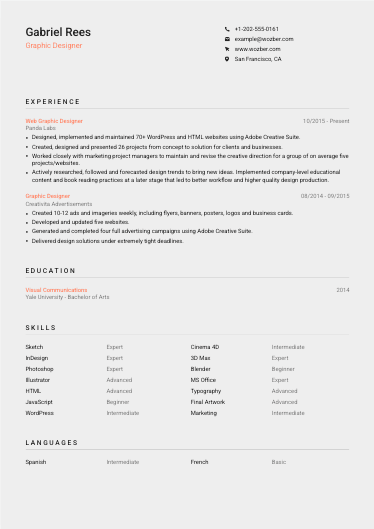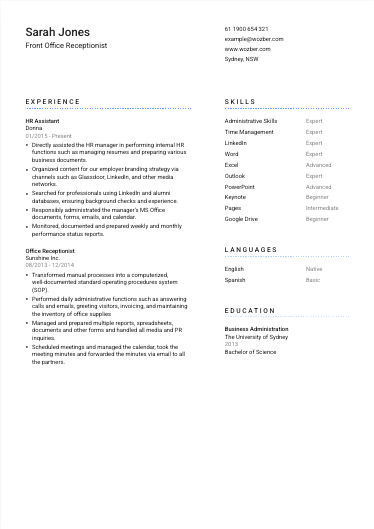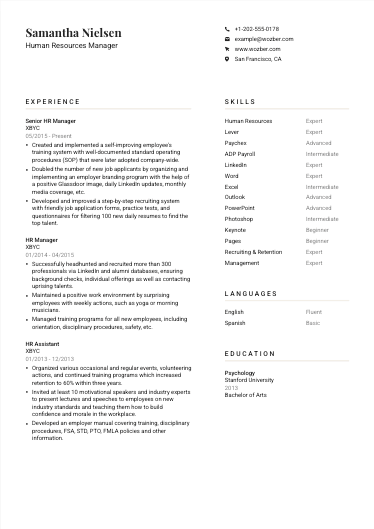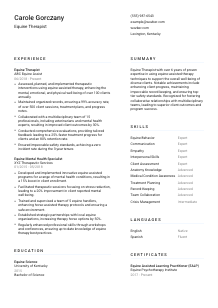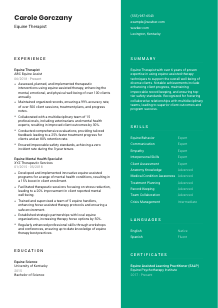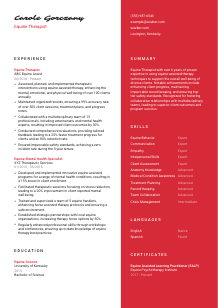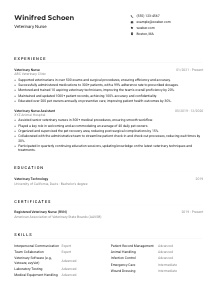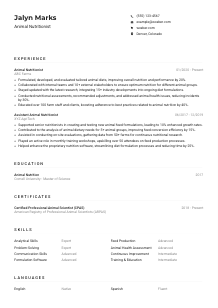Equine Therapist CV Example
Mending horse spirits, but your CV feels a bit unbridled? Trot into this Equine Therapist CV example, tacked together with Wozber free CV builder. Discover how to seamlessly saddle your healing insights with job requirements, galloping your career towards a therapeutic canter in the horse world!

How to write an Equine Therapist CV?
Hello, inspiring Equine Therapist! If you're looking to take the reins on your career with a CV that leaps over the competition, you've trotted to the right place. Creating a CV that mirrors the heart of the equine therapy profession isn't just about listing your experiences; it's about weaving your passion, skills, and dedication into a cohesive narrative that catches the eye of your dream employer. With the Wozber free CV builder guiding our journey, let's gallop through crafting a CV that not only meets the mark but surpasses it with grace, precision, and a touch of equine empathy.
Personal Details
First impressions count, and in the world of job hunting, your Personal Details section is the gate through which hiring managers gallop. Let's saddle up and ensure yours is primed for the job, straight out of the gate.
1. Identify With Your Name
Your name is the banner under which your professional journey unfolds. Make sure it stands proudly at the top of your CV, in a font that's professional yet distinctive, ensuring you're remembered.
2. Embrace the Role
Like fitting a horse with the right saddle, make sure the job title matches your aspirations. Directly under your name, indicate you're applying for the "Equine Therapist" role to show alignment with the job opening.
3. Point to Your Paddock
Location, location, location! With this role stationed in Lexington, Kentucky, spotlighting your residence in this locale or your willingness to relocate without hassle is a plus. This small detail ensures you're seen as a practical and easy fit.
4. Offer a Means to Connect
Think of your contact details as the rope that ties you to your future employer. Include a professional email address and a phone number where you're readily available. Consider adding a LinkedIn profile to provide a fuller picture of your professional paddock.
5. Skip the Unessential
Like keeping a stable tidy, exclude personal details not directly related to your professional role — age, marital status, or photo — to ensure the focus remains on your qualifications and experiences.
Takeaway
The Personal Details section is your opportunity to invite the hiring manager into your professional world. Craft it with care, ensuring it reflects the role you're aiming for with clarity and professionalism. Let this section serve as a polished, welcoming gate that leads into the remarkable journey of your career.





Experience
The arena of your CV is Experience. Here, every achievement and role you've held gallops under scrutiny. The goal? To showcase your journey in a way that resonates with the responsibilities and requirements of an Equine Therapist.
- Assessed, planned, and implemented therapeutic interventions using equine‑assisted therapy, enhancing the mental, emotional, and physical well‑being of over 100 clients annually.
- Maintained organized records, ensuring a 99% accuracy rate, of over 500 client sessions, treatment plans, and progress notes.
- Collaborated with a multidisciplinary team of 15 professionals, including veterinarians and mental health experts, resulting in improved client outcomes by 30%.
- Conducted comprehensive evaluations, providing tailored feedback leading to a 25% faster treatment progress for clients and an 80% retention rate.
- Ensured impeccable safety standards, achieving a zero incident rate during the 3‑year tenure.
- Developed and implemented innovative equine‑assisted programs for a range of mental health conditions, resulting in a 15% boost in client enrollment.
- Facilitated therapeutic sessions focusing on stress reduction, leading to a 20% improvement in client reported mental well‑being.
- Trained and supervised a team of 5 equine handlers, enhancing horse‑assisted therapy protocols and ensuring a safe environment.
- Established strategic partnerships with local equine organisations, increasing therapy horse options by 50%.
- Regularly enhanced professional skills through workshops and conferences, ensuring up‑to‑date knowledge of equine therapy best practices.
1. Align With the Job's Gait
Like matching your pace to a horse's gait, start by dissecting the job description. Highlight experiences directly mirroring phrases like "assessed, planned, and implemented therapeutic interventions" or "collaborated with a multidisciplinary team." This precision shows you're in step with the role.
2. Set Your Career Course
Organize your professional journey in a way that clearly demonstrates growth. Place your most recent (and relevant) experiences at the forefront, drawing a direct line from where you started to your aspiration to become an Equine Therapist.
3. Show, Don't Just Tell
For every role listed, craft accomplishment statements that show your impact. Use active language and quantify your achievements, for example, "enhanced mental, emotional, and physical well-being of over 100 clients annually." This brings your contributions to life.
4. Numbers Make the Narrative
Like tracking progress in therapy sessions, quantify your achievements wherever possible. Numbers provide tangible evidence of your impact and skill, making your experiences resonate more powerfully with hiring managers.
5. Relevance is Key
Ensure every experience listed ties back to the role you're applying for. Irrelevant experiences can dilute the strength of your CV, so keep your content focused and aligned with the job of Equine Therapist.
Takeaway
Your Experience section is where your professional journey takes center stage. Emphasize roles and achievements that demonstrate your capability and readiness for the position. Let your experiences be the proof that not only can you handle the job, but you're poised to make a significant positive impact as an Equine Therapist.
Education
Education in the field of equine therapy isn't just about collecting degrees; it's the foundation of your understanding and approach to healing. Let's ensure this section reflects your solid grounding and commitment to the profession.
1. Tailor Your Academic Trophies
Highlight your Bachelor's degree in Equine Science, Animal Therapy, or related fields, showing you have the essential educational grounding for the role. If the job description specifically mentions a preference for certain qualifications, make sure those are front and center.
2. Format for Clarity
Present your educational background in a clear, straightforward manner, starting with the most recent. Include the degree obtained, the field of study, and the institution's name, followed by the graduation year to provide a clear timeline of your academic journey.
3. Highlight Relevant Study Areas
Given the specialized nature of the Equine Therapist role, mentioning specific courses or projects related to equine behavior, anatomy, or therapy techniques can further align your education with job requirements.
4. Shine a Light on Extra Achievements
If your educational journey includes honors, relevant extracurricular activities, or special projects that showcase your dedication to equine therapy, make sure these are included. These details paint a picture of a well-rounded and committed candidate.
5. Professional Development Matters
Continuing education and professional development are key in the evolving field of equine therapy. Share any additional courses or workshops you've attended that add depth to your expertise.
Takeaway
Your education section should tell a story of dedication and direct alignment with the equine therapy profession. By carefully selecting what to highlight, you not only show your qualifications but also your passion and ongoing commitment to your field of expertise.
Certificates
In the equestrian world, the right training and certifications can set you apart. This section is your chance to shine, showcasing the specialized training that positions you as an expert in the field of Equine Therapy.
1. Harness the Right Certificates
Leading with relevant certifications such as Certified Equine-Assisted Psychotherapist (CEAP) demonstrates your commitment to the profession and aligns with the preferred qualifications for the job. Remember, quality trumps quantity.
2. Be Chronologically Clear
List your certifications in reverse chronological order, starting with the most recent. Include the issuing organisation and the date, to provide a clear timeline of your professional development.
3. Relevance is Your Bridle
Focus on certifications directly relevant to the role of an Equine Therapist. This direct linkage not only underscores your specializations but also illustrates your strategic educational choices.
4. Always Be Advancing
The field of equine therapy is ever-evolving, with new techniques and understanding emerging regularly. Show your commitment to staying at the forefront by pursuing ongoing education and certifications in areas relevant to your profession.
Takeaway
Your certificates section is a testament to your expertise and dedication to your craft. By strategically selecting which certifications to highlight, you position yourself as a well-qualified and forward-thinking candidate, ready to make significant contributions to the field of Equine Therapy.
Skills
As an Equine Therapist, your skills are the tools in your tack box. This section allows you to showcase the unique combination of technical and soft skills that make you the ideal candidate for the job. Let's refine and present them in a way that catches the employer's eye.
1. Bridle the Role's Skills
Take a deep dive into the job description and extract specific skills mentioned, such as "strong knowledge of equine behavior" and "exceptional communication." This direct correlation demonstrates your fit for the role.
2. Prioritize for Impact
While you may have a wide array of skills, focus on those most relevant to being an Equine Therapist. Placing soft skills like empathy and communication alongside hard skills such as treatment planning emphasizes your balanced toolkit.
3. Organize for Readability
Create a clear, concise list that allows hiring managers to quickly identify your expertise. A well-organized skills section ensures your strengths are immediately evident, facilitating a straightforward assessment of your fit for the role.
Takeaway
Your skills are the essence of your professional identity as an Equine Therapist. Carefully selecting and presenting them in your CV showcases your qualification and readiness for the role, making it clear to hiring managers why you're the best match for their team.
Languages
In the realm of equine therapy, the ability to communicate effectively is paramount. While the focus might be on non-verbal cues between therapist and horse, the capability to articulate thoughts and instructions in multiple languages can be an added boon. Here's how to harness the power of your linguistic skills.
1. Rein in the Requirements
If the job description emphasizes "Effective use of the English language," make sure this is highlighted at the top of your languages section, emphasizing you meet this critical requirement.
2. Showcase Additional Languages
Even if not listed as a requirement, additional languages can set you apart. Highlighting fluency in languages beyond English, like Spanish for instance, showcases your ability to communicate with a broader range of clients and colleagues.
3. Clarity in Proficiency
Be clear and honest about your language proficiency levels. Terms like "Native," "Fluent," "Intermediate," and "Basic" provide a quick understanding of your linguistic capabilities, ensuring no misinterpretations.
4. Consider the Role's Realm
For an Equine Therapist, languages may not be the primary focus, but showcasing linguistic skills, especially if the role involves interacting with a diverse client base, emphasizes your adaptability and readiness for a variety of situations.
5. Global Perspective
In our interconnected world, the ability to speak multiple languages speaks to your ability to engage with global trends, research, and knowledge in the field of equine therapy, adding depth to your professional profile.
Takeaway
Your linguistic capabilities, while not the main act, play a supportive role in showcasing your comprehensive skills as an Equine Therapist. They reflect your ability to connect and communicate, qualities that are invaluable in any therapeutic setting. Let your CV reflect the global citizen and skilled communicator that you are.
Summary
Your CV summary is the paddock where your professional essence grazes. Here, in just a few lines, you have the chance to encapsulate your journey, expertise, and the unique blend of skills that make you the ideal Equine Therapist.
1. Essence of Experience
Begin with a succinct statement that distills your professional identity, focusing on your experience and passion for equine-assisted therapy. This serves as an inviting handshake to the reader.
2. Key Achievements and Skills
Highlight your crowning achievements and core skills next. Use snippets like "enhanced client progress and maintained impeccable record-keeping" to paint a vivid picture of your impact and expertise.
3. Concise and Compelling
Keep your summary short and sweet, but powerful. Aim for 3-5 lines that draw the reader in, making them eager to learn more about your journey and what you bring to the table.
4. Tailored and Tuned
Ensure your summary is specifically tuned to the role of an Equine Therapist, mirroring the language and requirements of the job posting where applicable. This shows you're not just experienced, but the right fit for this particular role.
Takeaway
Your summary is the gate that leads into the rich pasture of your professional experiences and achievements. Craft it with intention, showcasing your strengths and passion for equine therapy, and invite your potential employer to see why you're the perfect fit for the role. Let this be the beginning of a mutually rewarding journey.
Launching Your Equine Therapist Journey
Congratulations on fine-tuning your CV into a showcase of your dedication and skills as an Equine Therapist. Remember, your CV is a living document — as you continue to grow and evolve in your profession, so should it. Keep it updated, and tailor it to each new opportunity that gallops your way. Use the insights and strategies explored here, along with the Wozber free CV builder, to ensure your CV remains both ATS-compliant and reflective of your unique journey in equine therapy.
Here's to your success in finding a role that allows you to thrive and make a meaningful impact in the lives of both your clients and their equine partners. Saddle up and set forth on your career path with confidence!

- Bachelor's degree in Equine Science, Animal Therapy, or a related field.
- Minimum of 3 years of hands-on experience in equine-assisted therapy or related fields.
- Certification in Equine Assisted Psychotherapy (EAP) or Equine Assisted Learning (EAL) strongly preferred.
- Strong knowledge of equine behavior, anatomy, and medical conditions.
- Exceptional communication, empathy, and interpersonal skills.
- Effective use of the English language is essential.
- Must be located in Lexington, Kentucky.
- Assess, plan, and implement therapeutic interventions to support the mental, emotional, and physical well-being of clients using equine-assisted therapy techniques.
- Maintain accurate and organized records of client sessions, treatment plans, and progress notes.
- Collaborate with a multidisciplinary team including veterinarians, mental health professionals, and horse trainers to ensure effective care.
- Conduct regular evaluations and provide feedback to clients and their families on treatment progress.
- Ensure the safety of clients, horses, and staff during therapy sessions and on the premises.

